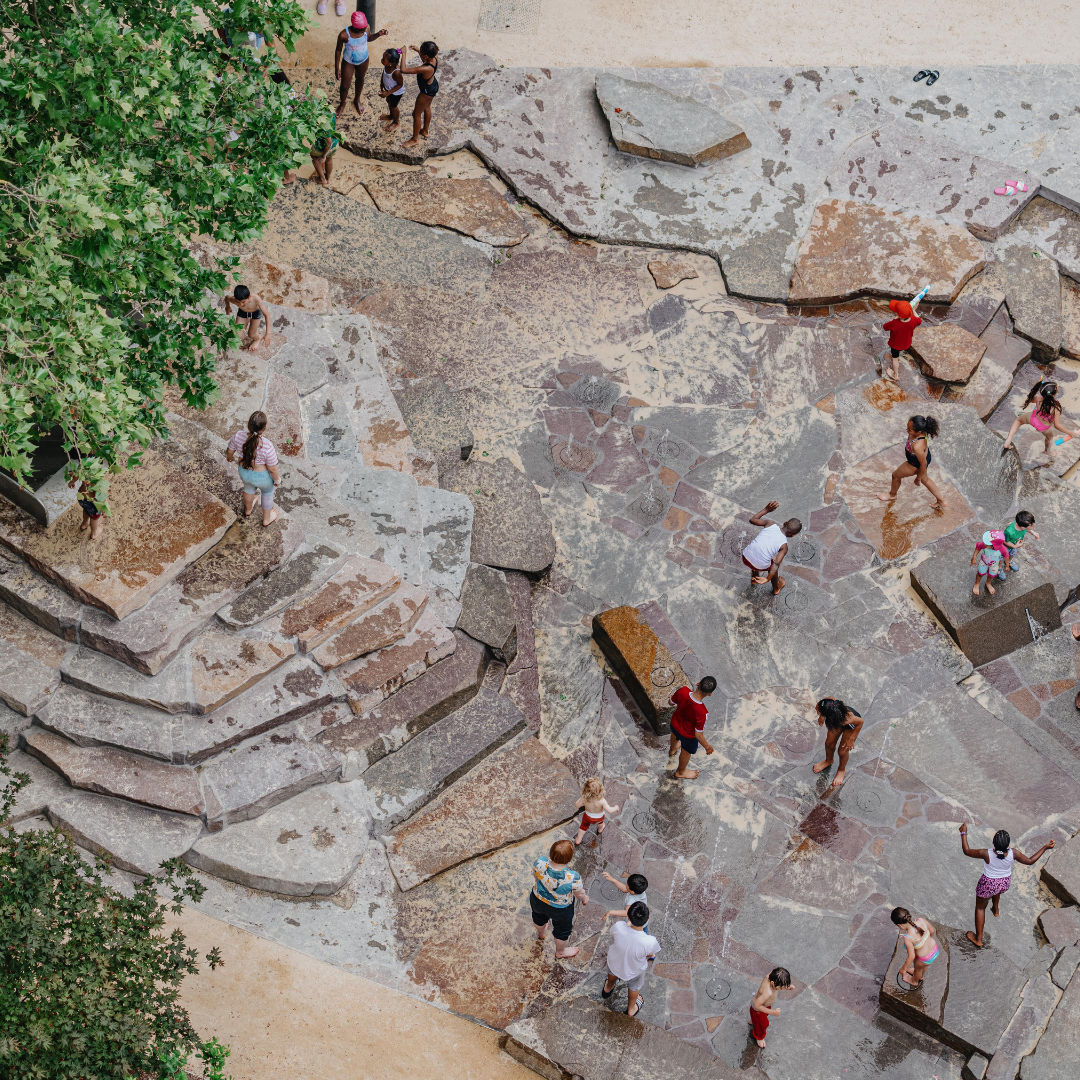Project showcase
The Park at Elephant Park, Southwark, London – Lendlease

Elephant Park’s central park is a stunning 2-acre green oasis including community space with expansive lawns, mature London plane trees, Elephant Springs, a landmark water playscape, and pedestrian walkways nestled among naturalistic planting.
Where is the project located
Elephant Park, Ash Avenue, London SE17 1FR
Who is the developer/client of the project?
Lendlease
Describe the context of this project and its neighbourhood and people?
The Park at the centre of Elephant Park is a spectacular green oasis at the heart of this joint venture development by Lendlease and Southwark Council. At 2-acres, it’s an inclusive community space featuring expansive lawns, mature London plane trees, the landmark water playscape, Elephant Springs, and pedestrian walkways nestled within naturalistic planting.
Located less than a five-minute walk from Elephant & Castle’s underground and British rail links, and the busy New Kent and Walworth Roads, the space has been designed as a multifunctional environment for those living, visiting or working in the area to have an opportunity to slow down, relax and connect with nature.
The Park is sited on land previously occupied by the Heygate Estate. The design and layout of this estate meant it was difficult for pedestrians to pass through the area due to the barrier-like structures of the buildings and roads. In creating the Park, Lendlease have opened up this land to be much more permeable, bringing a network of footpaths and new streets for the community to use. This in turn encourages greater take up of walking and cycling, and helps to improve the community’s physical wellbeing.
Extensive consultation events, differing in style and location, were carried out in 2019 to engage with diverse groups of people from as many areas of Elephant & Castle as possible.
These findings played a key role in the final design, particularly in the retention of the 27 mature London plane trees, preserved from the Heygate Estate.
Tell us what you did and how it was designed and delivered. What do you see as the greatest success of this project?
The design of the park has been developed in close collaboration with the local community, and key feedback was that they wanted:
- A place to be proud of and which was unique to London
- Open green space and nature in abundance
- A place that was safe
- Plentiful seating in different styles
Early designs of the park had an access road abutting the northern edge of the park. The design was changed following community feedback so that this space would be pedestrianised, enabling the retail units bordering the park to have direct access for their customers onto the green space. The perimeters of the park were also changed from early designs by landscape architects Gillespies. The straight edged, rectangle format of the early park design was replaced with one where the edges were curving, and more naturalistic, welcoming park users into the space.
Lendlease had always planned there would be a play area within the park, but community-consultation prompted raised ambitions in terms of what could be achieved. Elephant Springs is the result of questioning what can be created that appeals to all age groups and all backgrounds; that is accessible to all, and which the local community can be proud of. Designed by artist Mel Chantrey from the Fountain Workshop, Elephant Springs is a unique rocky, watery landscape with beaches, waterfalls, hammocks and slides. There is nowhere else like it in London, and its greatest success is how it’s been positively received by the local community.
How does this public space bring people together, encourage inclusivity, and make a positive environmental impact to the wider place? How is the community engaged in the project?
The wide-open lawns, extensive seating options and inclusion of Elephant Springs have created a wholly democratic space within Elephant & Castle, where diverse park users meet friends and make new ones, brought together by either walking their dogs, their children playing together, or just a shared appreciation for the space. The Park is designed to be fully accessible, and wheelchair users can even enjoy getting caught by the ‘ambush jet fountains’ within the rocky Elephant Springs.
There are regular events taking place within the park, either organised by Lendlease, or the community themselves, with the mandate that these must be open to all. 2021’s activities include a community pumpkin display for Halloween across Elephant Springs and a light display to celebrate Diwali.
From an environmental perspective the mature trees play an important role in mitigating climate change. Their canopy helps cools the air, mitigates pollution and provides wildlife habitats. The inclusion of rain gardens helps to manage the rainwater falling on the site and reduce the impact on the surrounding overburdened drainage networks.
Wherever possible, materials have been reused or sustainably sourced. The main pathway is paved in self-binding gravel, a softer material with a lower carbon footprint than imported stone paving. Natural stone paving is only used in heavy footfall areas and within the Elephant Springs water feature. Where stone is utilised, European stone has been selected for its lower carbon footprint.
Please share any data or figures that support your entry about how this public space or landscape intervention has made a positive social or environmental impact, for example biodiversity, increased dwell time, flood or drainage mitigation, wellness or safety or other ecosystem services.
From an environmental perspective, the Park provides a green oasis in London’s zone one where the local community can relax, play, exercise and socialise. It includes 27 retained, mature trees and 19 new trees, chosen for their suitability for conditions, resilience to climate change, and diversity of species to mitigate biosecurity issues and deliver comprehensive ecological value to the Park. The wider planting strategy has a mix of native and non-native species to maximise diversity and create a spatially complex planting cover that, according to many academic studies, has the most significant impact on supporting biodiversity.
The extensive tree canopy cools the air, mitigates pollution, and provides microclimatic improvements alongside habitats for wildlife. The design focused on maximising planting and reducing hard paving, allowing all opportunities where possible for the carbon sequestering properties of soil. The Park’s rain gardens are a vital part of the SUDS strategy, infiltrating surface water runoff from hard paved areas into the underground aquifer rather than overburdening London’s combined sewer system.
From a social impact perspective, the park is somewhere diverse groups from the community can come together and enjoy the space. Feedback via social media from last summer was overwhelmingly positive and some examples are included in the supporting documents. Research carried out by the data consultancy CACI Ltd show that the park is being visited in equal numbers by demographics of varying affluence, demonstrating that our objective in designing a place for diverse groups to come together is working.
Festival of Pineapples
24-26 February 2026
Pineapples prize giving night
April
Pineapples at Festival of Place
10 June 2026
© The Pineapples - Tweak Ltd. 124 City Road, London, EC1V 2NX. Tel: 020 3326 7238




